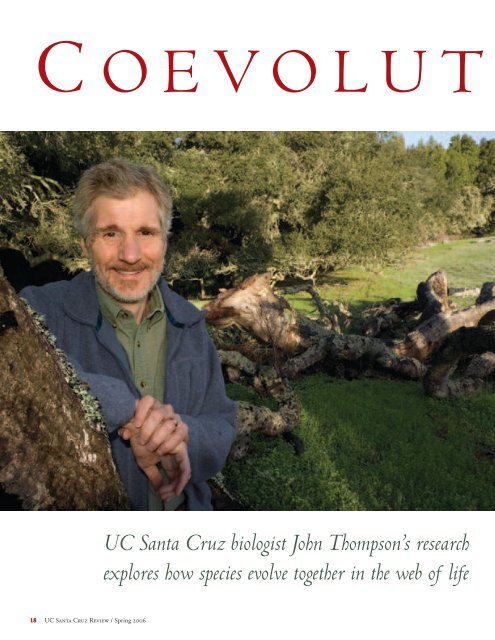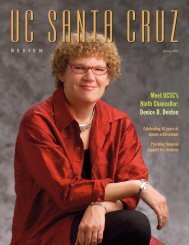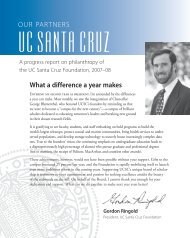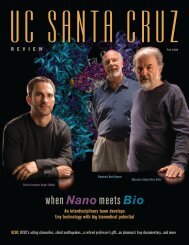Spring - Review Magazine - University of California, Santa Cruz
Spring - Review Magazine - University of California, Santa Cruz
Spring - Review Magazine - University of California, Santa Cruz
You also want an ePaper? Increase the reach of your titles
YUMPU automatically turns print PDFs into web optimized ePapers that Google loves.
C O E V O L U T I O N<br />
18 UC <strong>Santa</strong> <strong>Cruz</strong> <strong>Review</strong> / <strong>Spring</strong> 2006<br />
UC <strong>Santa</strong> <strong>Cruz</strong> biologist John Thompson’s research<br />
explores how species evolve together in the web <strong>of</strong> life<br />
jim mackenzie<br />
By Tim Stephens<br />
In the creeks and woodlands around San Francisco Bay,<br />
garter snakes and newts are engaged in a biological arms race—<br />
the snakes eat newts, the newts produce a potent neurotoxin in<br />
their skin, the snakes evolve resistance to the toxin, the newts evolve to<br />
produce more toxin, and so on. While the newts still fall prey to toxinresistant<br />
snakes, even a resistant garter snake may be incapacitated for<br />
hours after eating a highly toxic newt.<br />
This situation has evolved over time as a result <strong>of</strong> “tit for tat”<br />
evolutionary changes driven by natural selection—a classic example<br />
<strong>of</strong> the coevolution <strong>of</strong> two interacting species.<br />
Coevolution shapes all kinds <strong>of</strong> interactions between species—<br />
not only the antagonistic interactions <strong>of</strong> predators and prey or parasites<br />
and their hosts, but also mutually beneficial partnerships like those <strong>of</strong><br />
flowering plants and their pollinators. In fact, most plants and animals<br />
depend on coevolved interactions with other species in order to survive,<br />
says John Thompson, an internationally recognized authority on<br />
the subject.<br />
“Much <strong>of</strong> evolution turns out to be coevolution, and ecological<br />
communities are based on these deeply coevolved relationships between<br />
species,” says Thompson, a pr<strong>of</strong>essor <strong>of</strong> ecology and evolutionary<br />
biology at UC <strong>Santa</strong> <strong>Cruz</strong>.<br />
Thompson’s research explores the role <strong>of</strong> coevolution in organizing<br />
the web <strong>of</strong> life on Earth. The potential applications extend from<br />
medicine and agriculture to conservation <strong>of</strong> the Earth’s biodiversity.<br />
“It turns out that many <strong>of</strong> the major societal problems we face in biology<br />
are problems involving coevolution,” he says.<br />
Thompson, who published his third book on coevolution last year,<br />
has been a leading player in the field’s rapid growth over the past decade.<br />
One <strong>of</strong> his major accomplishments has been to establish a coherent<br />
The snake and the newt:<br />
Trapped in a biological arms race<br />
The moth and the flower:<br />
Mutually beneficial, but not always<br />
UC <strong>Santa</strong> <strong>Cruz</strong> <strong>Review</strong> / <strong>Spring</strong> 2006 19<br />
olle pellmyr edmund d. brodie iii





